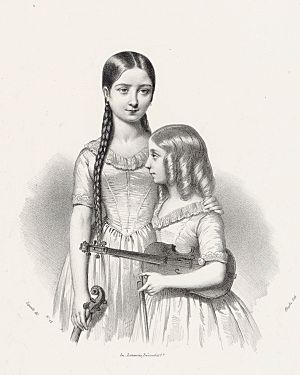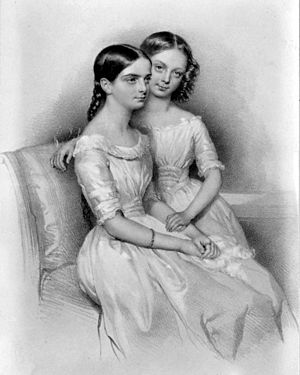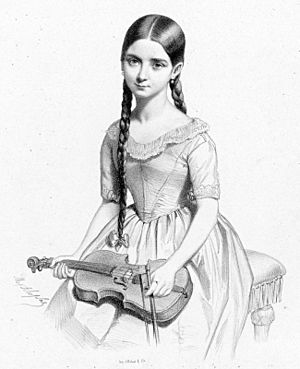Teresa and Maria Milanollo facts for kids
Teresa (1827–1904) and her younger sister Maria (1832–1848) Milanollo were Italian violin players. They were known as child prodigies because they were incredibly talented at a young age. They traveled all over Europe in the 1840s and everyone loved their music.
Sadly, Maria passed away when she was only 16. Teresa, who also wrote music, continued her career as a solo artist for many years. The name "Milanollo" lives on in a special way! A famous march played by the Life Guards, Coldstream Guards, and Governor General's Foot Guards is named "Milanollo" in their honor. Also, the Teatro Milanollo (Milanollo Theater) in their hometown of Savigliano was named after the sisters.
Teresa started learning violin when she was very young. She had teachers like Ferrero, Caldera, and Morra. She gave her first concert in Savigliano when she was just nine years old. In 1836, her family moved to Paris. She toured places like Britain, France, the Netherlands, and Belgium. Sometimes, her famous teachers, Lafont, Habeneck, and de Bériot, played with her. Later, Teresa became Maria's first and only violin teacher.
From 1838 to 1848, the Milanollo sisters toured many countries. They played for kings and queens and famous composers like Johann Strauss the Elder, Berlioz, Liszt, Chopin, and Meyerbeer. People gave them fun nicknames: Maria was "Mademoiselle Staccato" because she played quick, short notes, and Teresa was "Mademoiselle Adagio" because she was more serious and played slower, flowing music. Teresa was seen as the true musical genius of the two.
After Maria's sad death in 1848, Teresa kept performing solo. She started special "Concerts aux Pauvres" (charitable concerts) where she raised money for people in need. She stopped performing professionally in 1857 when she got married. Teresa passed away in Paris in 1904.
Teresa Milanollo was a pioneer, meaning she was one of the first important women violinists. Even though her own musical pieces are not often played today, some of her violins are still around. These include a 1728 Stradivarius violin, which was once played by Paganini, and a smaller 1680 Ruggieri violin that belonged to Maria.
Contents
The "Milanollo" March
The music for the "Milanollo" march was written by a German composer named Johann Valentin Hamm in the 1800s. He wrote it to honor the amazing Milanollo sisters. They first played this tune in England in 1845 during their big European tours.
In the 1880s, the War Office (a government department) officially approved it as a march for the Coldstream Guards. The Coldstream Guards called it "Milanollo," and the official version was approved in 1882. For a while, from 1907 to 1936, it was known as "The Coldstream March." Today, it's called "The Coldstream March – Milanollo." Other army regiments, like the Life Guards and the Governor General's Foot Guards, also adopted this march.
The Milanollo Sisters' Story
The Milanollo sisters were incredible violin players. They were so talented at a young age that they were called "prodigies." They toured all over Europe in the 1840s and everyone loved their performances.
Their Early Lives
Birth and Family
Teresa and Maria were two of thirteen children! They were born in Savigliano, a town in Piedmont, Italy. Teresa was born on August 18, 1827, and Maria on June 18, 1832. So, Teresa was almost five years older than Maria. Their father, Giuseppe Antonio Milanollo, was often described as someone who made silk-spinning machines. But some people at the time also called him a "luthier," which means he made stringed instruments like violins.
Teresa's First Steps in Music
It makes sense that their father was a luthier, because he made a small wooden violin for Teresa. He also gave her basic music lessons. Teresa really wanted her own violin after she showed an interest in music at age four. One day, after leaving a church, her father asked if she had prayed. Teresa replied, "No, father, I did nothing but listen to the violin."
Teresa first learned violin from Giovanni Ferrero in Savigliano. When she was eight, she went to Turin to study with Giovanni Morra and Mauro Caldera. After her first concert in Savigliano, she played in Mondovì and other cities in Piedmont. People were very impressed! To help Teresa's growing career, the family moved to France in 1836. They traveled by walking and using mules to get to Marseilles for concerts.
A writer named Henry Lahee said that Teresa Milanollo's success really encouraged many women to start playing the violin.
Touring with Lafont
After playing concerts in Marseilles, the Milanollo family went to Paris. There, Teresa met the famous violinist Charles Philippe Lafont, who became her new teacher. She performed several concerts in Paris at the Opéra Comique.
In late 1836, Teresa toured Belgium and the Netherlands with Lafont. They played together in Brussels. In January 1837, Teresa performed in five concerts in Amsterdam. She was even asked to play for the royal family in The Hague. She continued playing concerts in cities like Utrecht, Delft, and Rotterdam.
London Adventures
In 1837, nine-year-old Teresa and her family moved to London. There, she took lessons from Nicolas Mori and Auguste Tolbecque. Teresa played with Mori in concerts at the Covent Garden Theatre.
She also performed at the King's Theatre in Haymarket in June 1837. This theatre is now called Her Majesty's Theatre, where the musical Phantom of the Opera has been playing for a long time.
A harpist named Nicolas-Charles Bochsa offered to manage Teresa's concerts in the UK. Unfortunately, he kept the money from her forty concerts in places like Liverpool and Wales.
In April 1838, Teresa Milanollo performed at a special dinner for the Theatrical Fund of the Covent Garden Theatre. Queen Victoria had just become queen and agreed to support the fund. A writer described the event as a "large room completely filled" and praised "that wonderful girl, Milanollo."
Teresa's father also managed to get her to play in concerts with the famous composer Johann Strauss the Elder starting in May 1838. She played in London's fancy Hanover Square Rooms with young pianist Ellen May.
Maria Joins the Show
When Teresa, who was eleven, returned to France in mid-1838, she started teaching violin to her little sister Maria, who was six. By June 19, 1838, they played their first official concert together. It was very unusual to see two female violinists, and it caused a huge stir! This led to the sisters becoming famous worldwide.
Teresa then went on a successful tour of Northern France, including Lille and Rouen. She played many concerts there.
From early 1840, Teresa, more and more often with Maria, performed in other parts of France. They played six concerts in Nantes, where the first book about the talented sisters was printed. Teresa was now thirteen and Maria was eight. A writer named Alice Diehl said in 1897 that Teresa was a true inspiration for women violinists. She said Teresa played with great feeling and skill, and her technique was as good as the best male players of the time.
Their father, Giuseppe, always wanted the best for his daughters. So, in summer 1840, Teresa began studying with François-Antoine Habeneck. He was a famous conductor and violinist in Bordeaux. Between October and December 1840, the young sisters played 12 very successful concerts in Bordeaux. They also played eight concerts in Orléans in February 1841.
Big Success and Grand Tours
From 1841 to 1845, when Teresa was fourteen and Maria was nine, the Milanollo sisters played for kings and queens across Europe. They also performed for, and sometimes with, famous composers like Berlioz, Chopin, Liszt, and Meyerbeer.
Teresa's Reputation Grows
On April 5, the two sisters played together in a concert hall in Paris. A critic named Henri Blanchard, who expected to be bored, said it turned out to be a "splendidly happy" event.
But it was a concert in Bordeaux on April 18, 1841, that really made Teresa famous. The composer Berlioz was there. Critics, including Berlioz, said her success was huge. Berlioz wrote that her performance was amazing not because she was young, but because of her beautiful music. He praised her clear sound, lively rhythm, and how well she played difficult notes.
On May 15, Teresa performed for Frédéric Chopin, George Sand, and Friedrich Kalkbrenner. After these successful shows, King Louis Philippe III invited the sisters to play for his family at his castle in Neuilly.
By now, the sisters were always together. Maria had been learning from Teresa since 1838, and Teresa was her first and only teacher.
Learning with de Bériot and More Tours
Teresa and Maria went on another long tour of northern France. In Boulogne, Teresa met Charles Auguste de Bériot, who became her teacher in Brussels. De Bériot taught her how to use the violin bow like a master and how to play perfectly in tune. Teresa later said that de Bériot "completed her artistic education."
The Milanollo sisters played throughout Belgium in cities like Antwerp and Brussels until April 1842. Then they toured Northern France again in the summer. Teresa often performed with a young Belgian pianist named Édouard Gregoir.
Germany, Austria, and Back Home
In September, they started a long tour of Germany in Aachen. A month later, in Cologne, the sisters had the honor of playing with Franz Liszt for King Frederick William IV of Prussia and William II of the Netherlands. In Frankfurt, where they played 13 concerts, another younger brother, Joseph, was born. The sisters then toured other German cities like Düsseldorf and Stuttgart through the spring of 1843.
On April 24, the Milanollo sisters gave their first concert in Vienna, Austria. They played 24 more concerts there! They were a huge hit, with the Empress Maria Anna of Savoy supporting them. People gave them nicknames based on their personalities: Teresa, who was more serious, was called "Mademoiselle Adagio," and Maria, who was more cheerful, was called "Mademoiselle Staccato." A famous composer, Otto Nicolai, even called them "angels of the violin."
After playing in many cities in the Austro-Hungarian Empire, they reached Trieste in August. Then they returned to their hometown of Piedmont, Italy, after being away for six years. They played concerts in Turin, Savigliano, and for the royal family at the castle of Govone. Between November 6 and 30, the sisters played 8 concerts in La Scala in Milan. In December 1843, they performed in Venice after concerts in Verona and Padua.
More Tours in Europe
From January 1844, the two violinists performed in Prague, Leipzig, and Dresden. In Berlin, they gave twelve concerts and played for the king, with Giacomo Meyerbeer joining them. They then held many concerts in other German cities, including ten in Hamburg.
They returned to Brussels, where Teresa continued to study. They spent the winter of 1844 touring Belgium. In early 1845, they played 17 concerts in Amsterdam. After a quick tour of Northern France, the Milanollos performed in Britain in summer 1845, even playing for Queen Victoria.
Maria's Passing
From early 1845 until 1847, the young sisters continued their tours. They visited places like Switzerland and Central France. In July 1847, they arrived in Nancy, France, and bought a house in Malzéville. In December 1847, they were invited to Lyon and played ten concerts.
The revolution of 1848 broke out, which stopped the sisters from playing 15 planned concerts at the Opéra. They went back to Malzéville for safety. But after a few months, Maria became ill and sadly passed away in Paris on October 21, 1848, from an illness called consumption. She was only sixteen years old.
About Maria Milanollo
Maria Milanollo was born in Savigliano, Italy, on July 19, 1832. She played concerts with her older sister Teresa until her early death in Paris on October 21, 1848. They were very successful in concerts in France, Germany, the Netherlands, and England.
Teresa was Maria's first violin teacher. Maria also learned a lot from Teresa's many famous teachers. Maria officially started performing on her sixth birthday in Paris, playing with Teresa. Within a couple of years, Maria became Teresa's constant partner. Most of her short life was spent on long European tours. Her health got worse after a concert in Arlon in July 1848.
Most people thought Teresa was the more talented of the two. A critic wrote that Maria was a "musical phenomenon" but like a "gentle imitation" of Teresa, who was already a great artist. However, Maria's playing, especially her quick, short notes (staccato) and fast groups of notes, was often considered even better than Teresa's.
Teresa's Solo Career
After a time of sadness for Maria, Teresa only played for charity for a few years. She started a series of concerts called "Concerts aux Pauvres" (Concerts for the Poor). She held these concerts in many major cities in France. Part of the money earned went to help the poor. She would often play a second concert for poor schoolchildren and their parents. After these performances, money, food, and clothes bought with the concert earnings were given out.
In 1852, she started touring again in France, Switzerland, Germany, and Austria. People said her playing was even better than before! From 1853 to 1856, she was at the peak of her abilities. Once, her skirt caught fire when she walked too close to the stage lights during a concert. She calmly put down her violin, put out the flames, and kept playing!
Concerts in Colmar
Teresa was 23 when she gave a sold-out concert in Colmar, France, on January 16, 1851. Another concert was quickly arranged for January 23. Critics were amazed, comparing her to Paganini, another famous violinist. One critic praised her "language so perfect, so simple that all understand it, because it goes straight to the heart." Another admired her skill with different violin sounds, saying it was "an enchantment to hear... sighing, moaning, murmuring then laughing, notes plaintive, strident, growling, languorous, ironic or passionate."
To end the concert, Teresa played her own composition, a fantasy piece. Another critic said her violin had "a living soul." She received so many flowers that she could barely carry them!
Marriage and Later Years
Teresa is said to have given her last public concert in Nancy on April 16, 1857, when she was twenty-nine. Later that day, she married Theodore Parmentier, a military engineer and amateur musician. Their wedding reception was held in a garden and attended by many officers. Captain Parmentier later became a general.
After her marriage, Teresa stopped her professional concert career. She followed her husband as he moved for his military duties, even traveling to Constantine, Algeria. She still performed for charity sometimes. For example, in 1860, a choir performed her piece Ave Maria. Her charity work became even more important after her mother died in 1869, especially during the Franco-Prussian War in 1870 when many people needed help. Teresa's very last public concert, not for charity, was in Paris in 1872.
After her father, Giuseppe Milanollo, passed away in 1878, Teresa and her husband lived quietly in Paris. She still attended special musical and social events.
Teresa Milanollo passed away on October 25, 1904, at the age of seventy-seven. Both sisters are buried in the Père Lachaise cemetery in Paris. Teresa gave many of her and her sister's musical items and documents to their hometown of Savigliano. Today, these items are on display in the city museum.
Teresa's Music
Teresa Milanollo wrote several musical pieces, though they are not widely known today. Some of her works include:
- Ave Maria
- Chorus for male quartet
- Fantaisie élegiaque for violin (written in 1853 to remember her sister Maria)
- Two romances
- Transcriptions and variations for violin and pianoforte
In 2016, a CD called "musica immortale" was released. It features 7 of Milanollo's compositions played by violinist Valentina Busso and pianist Eliana Grasso.
The Milanollo Violins
Teresa Milanollo owned some very special violins. These included a 1728 Stradivarius and a 1680 Ruggieri violin. The Ruggieri violin had belonged to the famous violinist Paganini. It was sold in 2010 by Tarisio Auctions. A book was even written about Teresa's Ruggieri violin.
The owner of the 1728 Stradivarius, Domenico Dragonetti, wrote in his will: "I give this violin, which was played by Paganini, to Teresa Milanollo." This violin, known as the "Milanollo-Dragonetti," has been played by Corey Cerovsek since 2004. It was also played by Paganini and Viotti a long time ago.
The smaller Ruggieri violin, called the "Milanollo" violin, belonged to her sister Maria. Inside the violin, you can see Maria's initials, "M.M."
A second Stradivarius violin was bought by Giuseppe Milanollo in 1841. Teresa used it for over five years before her father sold it in 1851. This violin is known as "Milanollo-Hembert" and is played today by Matteo Fedeli.
Milanollo Theatre in Savigliano
The Milanollo Theatre in Savigliano was designed by Maurizio Eula. It was first planned in 1834 and finished in 1836. The first show there was an opera called The Exile from Rome.
Outside the theatre, there's a Latin message that says the building was dedicated to two of the Muses (goddesses of art and science): "A group of friends... erected in 1835 this theatre to Melpomene and Talia, with the aim of embellishing and enhancing the souls of the people."
The Milanollo Theatre is described as a "delicate miniature" of a famous palace in Turin. It has a Neoclassical style with statues of Comedy and Tragedy. There are also carvings of flowers and portraits of famous writers.
The inside of the theatre is decorated with gold and stucco (a type of plaster). It can hold 350 people in three levels. The painting on the stage curtain shows Mount Parnassus, a mountain where the Muses lived. On the ceiling, a painting shows Psyche and Apollo.
In 1899, the theatre was officially renamed in honor of the Milanollo sisters.






